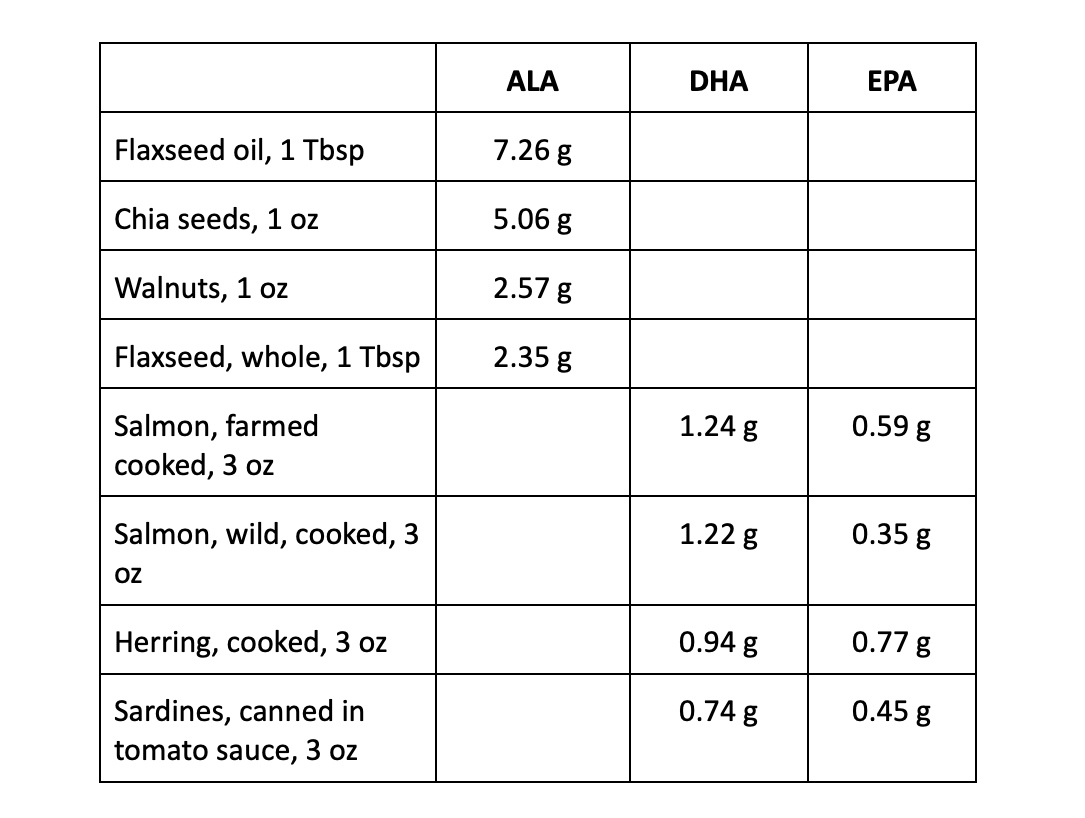Omega-3 and omega-6 fatty acids are essential fats that we need in order to survive. Learn the different types, the best ways to get it, and why paying attention to your omega-6 versus omega-3 intake is so important.
Omega-3 fatty acids are essential fats, in the form of polyunsaturated fatty acids, that our body needs for tissue growth and energy. They help make hormones that regulate the relaxation and contraction of artery walls, as well as inflammation. Omega-3 fats have been shown to help prevent heart disease, manage lupus, eczema, and rheumatoid arthritis, and may also protect against cancer.
Omega-3s are also critical elements of our cells’ membranes, found in abundance within our eye and brain cells, and provide our body with calories for energy. Omega-3s also play an important role in the functionality of our immune system, lungs, blood vessels, and heart.
There are three primary types of omega-3s: alpha-linolenic acid (ALA), eicosapentaenoic acid (EPA), and docosahexaenoic acid (DHA).
DHA and EPA are primarily found in fish and other types of seafood, while ALA is found in plant-sources like soybeans, vegetable oils, flaxseeds, and chia seeds.
Our bodies do not have the capability of producing their own omega-3s. In other words, bodies cannot make them from scratch, so it is important that we consume them from our diet. While we are able to convert ALA omega-3s into the EPA and DHA forms, we can only do so in minimal amounts, so ingesting EPA and DHA from eating omega-3 rich foods or supplements is the best way to ensure we are getting what we need.

Omega-3 fatty acids: a natural anti-inflammatory
Inflammation is an essential part of the immune system’s reaction to harmful infection and injury, and without it, we would not be able to properly heal. But induced inflammation that is not controlled can lead to serious diseases like heart disease, lupus, rheumatoid arthritis, and cancer.
Omega-3 fatty acids, particularly DHA and EPA, can alter the inflammatory response by suppressing it. In other words, omega-3s can help tame a potentially injurious, overstimulated immune reaction by lessening the amount of inflammation, possibly heading off disease, or improving disease symptoms, in the process.
What does this look like in action? Two prime examples can be found in cases of rheumatoid arthritis (RA) and inflammatory bowel disease (IBD), both autoimmune diseases that are characterized by chronic inflammation of the joints and digestive tract, respectively.
Research shows that RA patients who ingested an average 3.5g omega-3s in the form of fish oil supplements for a period of weeks to months had fewer inflammatory markers in their blood and experienced less joint pain and stiffness.
Likewise, omega-3s have the ability to favorably change the gut microbiota environment. The gut microbiota is the collection of trillions of bacteria that exists in our gastrointestinal tract.
Many different species of bacteria exist, and in the best-case scenario, they are diverse, in balance, and are evenly distributed. People who experience IBD are found to have lower diversity and an imbalance of these bacteria.
One study found that supplementing with a 4g mixture of EPA/DHA omega-3 over 8 weeks actually helped alter the bacterial composition in the gut to a healthier, more balanced one by decreasing certain bacteria and increasing others.
Omega-6 fatty acids: why you should be mindful of how much you are getting
Just like omega-3, omega-6 fatty acids are essential nutrients. There are four types of omega-6s: linoleic acid (LA), arachidonic acid (AA), gamma linoleic acid and conjugated linoleic acid.
LA is plentiful in nature. We can find it in safflower oil, sunflower oil, corn oil, soybean oil, walnuts, and pumpkin seeds. These fatty acids can also help with inflammation, however excessive amounts of omega-6 inhibits the anti-inflammatory effects of omega-3.
Omega-3 and omega-6 fatty acids compete for the same enzymes to produce other forms of omega-3 (DHA, and EPA) and omega-6 (AA). In the omega-6 family, LA is converted to AA, which is a precursor of proinflammatory mediators. Increasing the consumption of omega-3 fatty acid in your diet increases the production of anti-inflammatory mediators, which is why maintaining a balanced omega-6/omega-3 ratio is a critical factor for health.
In fact, several studies have found that a lower omega-6/omega-3 ratio is associated with a reduced risk of RA and obesity.
What about preventing heart disease?
Omega-3s have gotten some buzz over the years for their potential to help prevent heart-related diseases like heart attack and stroke. The thinking was that since these events might be initiated by the rupture of artery plaque, which is an inflammatory incident, the anti-inflammatory effect of EPA and DHA prevent the formation of plaque inside the arteries.

The best sources of omega-3s
Exactly how much omega-3s do we need, and where can we get it?
There is actually no universally recommended daily amount of DHA and EPA omega-3s we should take, but experts do provide a general guideline for suggested daily ALA amounts, because ALA is the only omega-3 that is essential.
Adult men should consume 1.6 g of ALA per day, whereas adult women should consume 1.1 g per day. ALA consumption is also recommended for pregnant and breastfeeding women, at 1.4 g and 1.3 g per day respectively.
So where should we be getting our omega-3s?
We should be getting omega-3s by eating a varied diet consisting of foods naturally high in them:
Fish - salmon, mackerel, sardines, tuna, herring
Nuts and seeds - walnuts, chia seeds, flaxseeds
Plant oils - canola oil, soybean oil, flaxseed oil

Certain brands of yogurt, juice, milk, eggs, soy drinks, and infant formulas are also fortified with omega-3s, and omega-3 dietary supplements including cod liver oil, fish oil, and krill oil are readily available as well.





